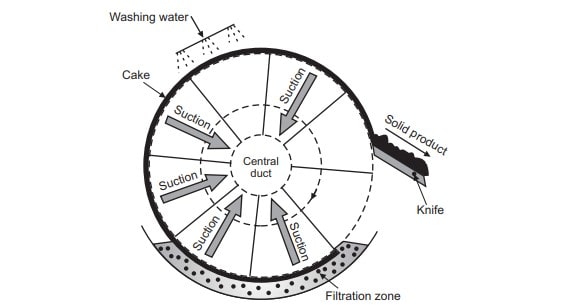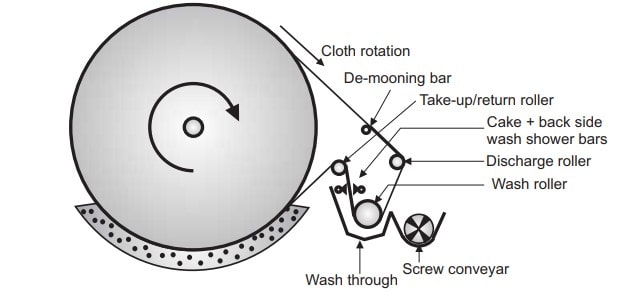In large-scale filtration, when continuous operation is desirable and it is necessary to filter slurries containing a high proportion of solids, The rotary drum filter, patented in 1872, is one of the oldest filters used in industrial liquid-solids separation. A rotary drum filter is one that is continuous in operation and has a system to remove the cake formed in addition, it can handle concentrated slurries too. It offers a wide range of industrial processing applications and provides a flexible application of dewatering, washing, and/or clarification.
Table of Contents
Construction for Rotary Filter
The rotary drum filter usually consists of 16 – 20 filter units. It has the shape of longitudinal segments of the periphery of a cylinder. The figure is shown below. Each filter unit is rectangular in shape with a curved profile and is joined to form a drum. Each unit has a perforated metal surface to the outer part of the drum and is covered with a filter cloth. Appropriate connections are again made from each unit through a rotating valve at the center of the drum. Rotary filters may be up to 2 m in diameter and 3.5 m in length, giving areas of the order of 20 m2. The drum is suspended on an axial over a trough containing liquid/solids slurry with approximately 50-80% of the screen area immersed in the slurry. One form is the rotary disc filter, in which the sector-shaped filter leaves form a disc with the outlet from each leaf connected to the vacuum system, compressed air, and the appropriate receivers, in the correct sequence, by means of a special rotating valve.
Special attachments may be included for special purposes; for example, if the cake shrinks and cracks as it dries out, cake compression rollers can be fitted. These compress the cake to a homogenous mass to improve the efficiency of washing as the cake passes through the washing zone, or to aid drainage of the wash water as the cake passes to the drying zone. Where the solids of the slurry are such that the filter cloth becomes blocked with the particles, a precoat filter may be used. This is a variant in which a precoat of filter aid is deposited on the drum prior to the filtration process. The scraper knife then removes the solid filtered from the slurry together with a small amount of the precoat. The knife moves slowly to avoid precoat removal.

An alternative discharge method can be used, for example, a string discharge rotary filter, the Figure is shown below. The string discharge filter is operated by means of a number of loops of string which pass the drum and cause the cake to form over the strings. The strings are in contact with the surface of the drum-up to the cake removal zone, where they leave the surface and pass over additional small rollers before returning to again contact the drum.

Working for Rotary Filter
The basic operating zones in a rotary filter are given in the table below. As the drum rotates into and out of the trough, the slurry is sucked on the surface of the cloth and rotated out of the liquid/solids suspension as a cake. When the cake is rotating out, it is dewatered in the drying zone.
| Zone | Position | Service | Connected to |
|---|---|---|---|
| Pick-up | Slurry trough | Vacuum | Filtrate receiver |
| Drainage | Vacuum | Filtrate receiver | |
| Washing | Wash sprays | Vacuum | Wash water receiver |
| Drying | Vacuum | Wash receiver | |
| Cake removal | Scraper knife | Compressed air | Filter cake conveyor |
The cake is dry because the vacuum drum is continuously sucking the cake and taking the water out of it. At the final step of the separation, the cake is discharged as a solid product and the drum rotates continuously for another separation cycle. In the case of a string discharge filter, the strings of the filter lift the filter cake of the filter medium, and the cake is broken by the sharp bend, over the discharge roller so that it is easily collected while the strings return to the drum.
Advantages for Rotary Filter
(i) The rotary filter is automatic and continuous in operation with very low labor costs.
(ii) These filters have a large filter area and thus a high output capacity.
(iii) Variation of the speed of rotation enables the cake thickness to be controlled, For example, for solids that form an impermeable cake, the thickness may be limited to less than 5 mm, and for coarse solids forming a porous cake, the thickness may be 100 mm or more.
Disadvantages
(i) This filter has ancillary components such as vacuum pumps, vacuum receivers and traps, slurry pumps, and agitators with many moving parts it is a complex piece of equipment.
(ii) The cake tends to crack due to the air drawn through by the vacuum system so washing and drying are not efficient.
(iii) Being a vacuum filter the pressure difference is limited to 1 bar and hot filtrates may boil.
(iv) The rotary filter is suitable only for straight forward slurries, being less satisfactory if the solids form an impermeable cake or will not separate cleanly from the cloth.
Applications
(i) The rotary filter is most suitable for continuous operation on large quantities of slurry.
(ii) It is used in the collection of calcium carbonate, magnesium carbonate, and starch.
(iii) It is especially useful for filtering the fermentation liquor in the manufacture of antibiotics where the mould is difficult to filter by ordinary methods because it forms a felt-like cake.
(iv) It is useful for slurries that contain a considerable amount of solids (15-30%).
Read too: Cartridge Filters